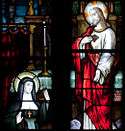Normae Congregationis
Normae Congregationis (NC) is a 1978 document written by the Vatican's Sacred Congregation for the Doctrine of the Faith (SCDF) concerning guidelines for Catholic bishops in discerning claims to private revelation such as apparitions. It includes the manner of discernment, the criteria for judging good and bad fruits, when church authorities can intervene, what authorities are competent to intervene, and the intervention of the Holy See.
Origin
In November 1974, when the Sacred Congregation for the Doctrine of the Faith met for its annual Plenary Congregation,[1] part of the discussion concerned problems relating to reported apparitions and revelations. New developments in theology and psychology prompted questions on how to evaluate claims of such events.
The eventual fruit of those discussions was a four-page document in Latin bearing the title "Normae S. Congregationis pro doctrina fidei de modo procedendi in diudicandis praesumptis apparitionibus ac revelationibus" ("Norms of the Sacred Congregation for the Doctrine of the Faith on the Manner of Proceeding in Judging Presumed Apparitions and Revelations", hereinafter Normae Congregationis or NC). The document was approved by Pope Paul VI in February 1978 and was signed by Franjo Cardinal Seper and Archbishop Jérôme Hamer, then the prefect and secretary of SCDF.
The Holy See decided that the text was an "in-house" document intended for bishops, and as such did not need to be published.[1] It was given to bishops “sub secreto” and not published in the Holy See's official journal Acta Apostolicae Sedis.
Publication
Though Normae Congregationis was originally issued sub secreto, excerpts from the text and translations of it appeared in print and on the internet from 1994 to 2010.[2][3][4]
In 2012 the Congregation for the Doctrine of the Faith released the text to the public in Latin and five vernacular translations with a new preface by Cardinal William Levada, prefect of CDF.[5][6]
The Constats
There has been some discussion concerning NC's presentation of the possible judgments that may be given by a diocesan bishop on a claim to private revelation.[7] There are traditionally three such possible judgments in Catholic theology:
- Constat de supernaturalitate ("It is confirmed to be of supernatural origin")
- Non constat de supernaturalitate ("It is not confirmed to be of supernatural origin")
- Constat de non supernaturalitate ("It is confirmed to be of non-supernatural origin")
Because NC mentions only the first two options, there is a question of whether or not CDF decided to forego the third "constat" and collapse its meaning into the second.
References
- 1 2 Gianni Cardinale (interview with Abp. Amato). "Tempi e criteri per "giudicare" le apparizioni". Eroici Furori (originally from Avvenire). Archived from the original on March 8, 2012.
- ↑ Joachim Bouflet and Philippe Boutry (1997). Un signe dans le ciel. Grasset. (in French)
- ↑ James Mulligan (2008). "Medjugorje: What's Happening". London: Dusty Sandals Press. (in English, based on the French of Bouflet and Boutry)
- ↑ Rene Laurentin; Patrick Sbalchiero (2007). "Dictionnaire des apparitions de la Vierge Marie ("Dictionary of Marian Apparitions")". Laurentin also provides the Latin word "taxativa" in NC I:B with respect to the positive and negative criteria being "indicative standards and not final arguments" (as Bouflet/Boutry and Foley translate).
- ↑ "NORMS REGARDING THE MANNER OF PROCEEDING IN THE DISCERNMENT OF PRESUMED APPARITIONS OR REVELATIONS". Congregation for the Doctrine of the Faith. Retrieved 22 May 2012.
- ↑ Cardinal William Levada. "Preface". Retrieved 22 May 2012.
- ↑ Richard Chonak (March 21, 2010). "Has Medjugorje already received a negative verdict?". Catholic Light (blog).
See also
External links
- Latin text
- Official English translation
- Preface by CDF prefect Cardinal William Levada
- English translation by Donal Foley
- 2010 English translation
- Is seeing believing? How the church faces claims of Marian apparitions
